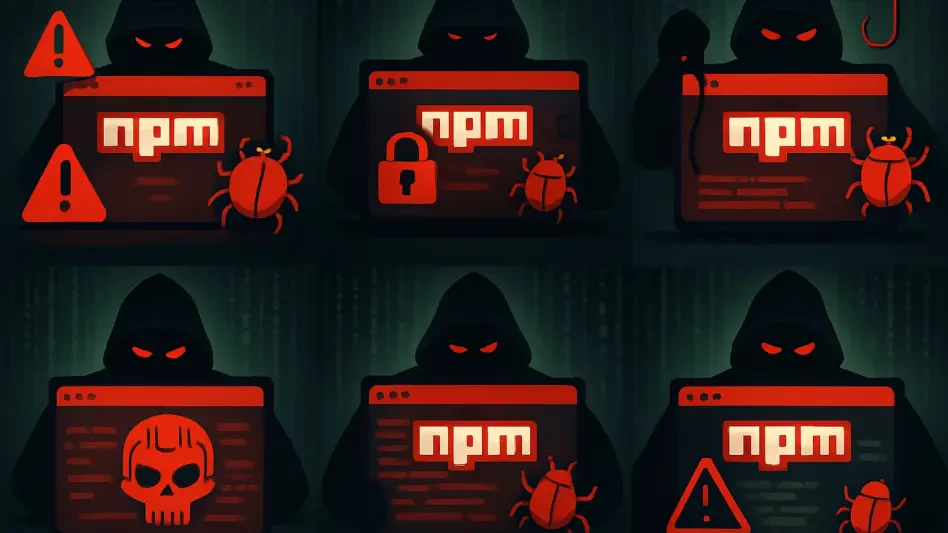Imagine a seemingly harmless utility library, downloaded thousands of times by developers, quietly extracting sensitive user data in the background without their knowledge. This scenario became reality with the discovery of Fezbox, a malicious npm package designed to steal credentials through advanced obfuscation techniques. As software supply chains become increasingly integral to modern development, the risks posed by such threats highlight a critical need for vigilance and robust security measures.
The purpose of this FAQ is to address the most pressing questions surrounding this sophisticated cyber threat. By exploring its mechanisms, implications, and preventive strategies, the content aims to equip developers and organizations with the knowledge to protect against similar attacks. Readers can expect clear answers, practical insights, and a deeper understanding of evolving dangers in open-source ecosystems.
This discussion will cover the specifics of how Fezbox operated, the broader trends in supply chain attacks, and actionable steps to mitigate risks. The goal is to provide a comprehensive yet accessible guide to navigating these complex cybersecurity challenges.
Key Questions
What Is Fezbox and How Does It Target Credentials?
Fezbox emerged as a deceptive npm package, masquerading as a legitimate JavaScript/TypeScript utility library while embedding malicious code to steal user credentials. Its primary target was sensitive data stored in browser cookies, such as usernames and passwords, which it transmitted to an external domain. This dual nature—functional yet harmful—made it particularly insidious, as it could blend into regular development workflows unnoticed.
The importance of understanding Fezbox lies in its potential to compromise countless systems through a trusted repository like npm. Unlike straightforward malware, this package employed intricate methods to hide its intent, making detection challenging without specialized tools. Its presence in a widely used ecosystem underscores the vulnerability of open-source platforms to such exploits.
Reportedly removed from the npm repository after being flagged, the incident still serves as a cautionary tale. While the direct impact may have been limited due to modern applications rarely storing passwords in cookies, the breach of trust in a popular package manager remains a significant concern. This case exemplifies the need for heightened scrutiny of dependencies in software projects.
How Did Fezbox Conceal Its Malicious Intent?
The malware utilized multiple layers of obfuscation to evade detection, showcasing a high degree of sophistication. Techniques included reversed strings for URLs, Unicode escapes, and even steganography, where malicious payloads were hidden within a QR code image. This approach differs from typical QR code phishing, as no user interaction was required; the payload activated automatically upon execution.
Such methods are critical to understand because they reveal how attackers can hide harmful code in plain sight. The use of a QR code for steganography was particularly innovative, as these codes naturally encode data, making the embedded malware less suspicious at initial inspection. This tactic demonstrates an alarming trend toward more creative and complex concealment strategies.
Experts have noted that static analysis alone struggles to identify threats employing such advanced obfuscation. The ingenuity behind these techniques serves as a reminder that traditional security measures may fall short against determined adversaries. Continuous monitoring and behavior-based detection are increasingly necessary to counter these evolving risks.
What Are the Broader Implications of Fezbox for Software Supply Chains?
The Fezbox incident is part of a larger pattern of supply chain attacks targeting open-source ecosystems. Recent campaigns, such as the Shai-Hulud worm and the compromise of a developer’s npm account affecting 18 packages with billions of weekly downloads, highlight the scale and persistence of these threats. Even when financial damage is minimal, as in the latter case with a theft of just over $1,000 in cryptocurrency, the potential for disruption is immense.
This trend is significant because software supply chains are foundational to modern development, yet they remain a weak link for many organizations. Attackers exploit the trust placed in repositories like npm, knowing that a single malicious package can propagate through numerous projects. The Fezbox case amplifies concerns about the security of dependencies that developers rely on daily.
The growing complexity of obfuscation methods further complicates the landscape. As threat actors refine their approaches, the cybersecurity community must adapt with more dynamic defenses. This ongoing challenge emphasizes that protecting software supply chains requires not just reactive measures but also proactive strategies to anticipate and neutralize emerging threats.
How Can Developers and Organizations Protect Against Similar Threats?
Mitigating risks like those posed by Fezbox demands a multi-faceted approach to security. Developers should prioritize vetting packages before integration, using tools that scan for suspicious behavior or anomalies in code. Additionally, maintaining an up-to-date inventory of dependencies ensures visibility into potential vulnerabilities within a project.
Beyond individual efforts, organizations must invest in advanced detection mechanisms. Behavior-based analysis, which monitors how code executes rather than just its structure, proves more effective against obfuscated threats. Continuous dependency monitoring can also flag unusual activity early, preventing widespread compromise.
Collaboration within the industry is equally vital. Sharing threat intelligence and supporting initiatives for stronger repository security can bolster collective defenses. By adopting these practices, the development community can build resilience against sophisticated attacks, ensuring safer software ecosystems for all stakeholders.
Summary
The key points surrounding Fezbox reveal the intricate tactics cybercriminals employ to exploit trusted platforms like npm. This malicious package, with its advanced obfuscation and credential-stealing capabilities, underscores the vulnerability of software supply chains. Insights into its operation, from QR code steganography to automatic payload execution, highlight the urgent need for evolved security measures.
The broader implications point to a persistent and growing challenge within open-source ecosystems. Main takeaways include the limitations of static analysis and the critical role of behavior-based detection in identifying threats. These findings stress that vigilance and adaptability are essential for safeguarding against sophisticated supply chain attacks.
For those seeking deeper exploration, resources on npm security best practices and reports from threat research teams offer valuable perspectives. Staying informed about emerging obfuscation techniques and mitigation strategies remains a priority for anyone involved in software development or cybersecurity.
Final Thoughts
Reflecting on the Fezbox incident, it became evident that the battle against cyber threats had entered a new phase of complexity. The ingenuity displayed by attackers in concealing malicious intent demanded a shift in how security was approached. This episode served as a wake-up call to reassess the trust placed in open-source repositories.
Moving forward, adopting proactive measures like enhanced monitoring and community collaboration proved crucial. Developers and organizations alike needed to prioritize tools and practices that could keep pace with evolving threats. By taking these steps, the industry could strengthen its defenses and reduce the risk of similar breaches in the future.
Consideration of how these lessons applied to specific projects or environments was essential. Evaluating current dependency management practices and investing in robust security frameworks offered a path toward greater protection. Embracing a mindset of continuous improvement ensured that the digital landscape remained secure against even the most sophisticated adversaries.








